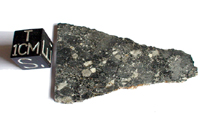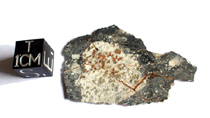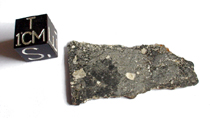LUN A - Anorthositic Highland Rocks
The members of this group are designated "LUN A" for their
mineral compositions. They are anorthosites, consisting primarily of
calcium-rich plagioclase with only minor pyroxene and olivine. Originally,
they were coarse-grained, plutonic rocks, forming the ancient highlands
that dominate both sides of the Moon. Over time, these rocks were
thoroughly granulated, heavily brecciated, and partially melted by
impacts, leading to the establishment of three subtypes of lunar
anorthosites - regolith breccias, impact-melt breccias, and fragmental
breccias.
Regolith breccias: The lunar surface is covered by a thick
regolith layer, and consequently, most lunaites are polymict regolith
breccias. These rocks consist of abundant white clasts of anorthositic
rock and minor dark clasts of highland basalts, combined with various
mineral and glass fragments, and mixed with a dark matrix of solidified
rock powder. This regolith also contains traces of meteoritic material
from many impactors, as well as characteristic amounts of solar
wind-implanted noble gases. Typical anorthositic regolith breccias are ALH
81005, the first meteorite recognized as a lunar rock, Dar al Gani 262,
the first Saharan lunaite, and Dhofar 025, a recent find from Oman.
However, some atypical members also contain abundant inclusions of lunar
mare lithologies, e.g., the famous Calcalong Creek. It consists of
approximately 50% highland anorthosite, 20% KREEP basalt, and 15%
low-titanium mare basalt, together with other minerals that are typical
for the lunar maria. Calcalong Creek can be regarded as a transitional
specimen between anorthositic highland regoliths and mare basalt regoliths.
Recent research suggests that it probably formed between the lunar
highlands and Oceanus Procellarum, one of the largest basaltic basins on
the near side of the Moon.
Impact-melt breccias: The lunaites of this group are polymict
breccias displaying characteristics of severe shock-metamorphism, partial
melting, and recrystallization, suggesting that they are the products of
larger impact events. Compositionally, they are similar to other
anorthositic lunaites, and they consist primarily of plagioclase and minor
accessory minerals. The members of this subgroup, such as Dar al Gani 400,
Dhofar 026, and the beautiful white-colored NWA 482, were all recovered
from the hot deserts of Africa and Oman during the last four years.
Fragmental breccias: The rare members of this subgroup are
polymict breccias that, at least superficially, resemble anorthositic
regolith breccias. They are composed of anorthositic rock fragments and
other, mostly felsic, clasts, in a fine-grained matrix of pyroxene and
olivine. However, they lack the regolith components and the implanted
noble gases characteristic of other regolith breccias. Obviously, they
represent the deeper layers of the lunar surface, of which only a few
members are known. The only anorthositic fragmental breccia available to
the collector is Dhofar 081 and its pairing, Dhofar 280. Both meteorites
were found in close proximity to each other, and similarities in structure
and composition suggest that they both are part of a single fall. >>
top...
|
DAG 400
Dar Al gani 400
Lunar Anorthositic Breccia
found March 10 Th 1998
TKW : 1425 gr
|
 
|
|
|
|
DAG400- 00
very nice slice of lunar meteorite !
2.84gr
Price on
request
|
|
|
|
|
|
|
|
DAG400- 01
Nice slice with a rare white inclusion unpubished !
2.05gr
4920 $
|
|
|
|
  |
|
|
|
|
|
|
 
|
|
|
|
DAG400- 03
Nice slice !!!
1.59 gr
SOLD
|
|
|
|
|
|
|
|
|
|
|
|
|
|
|
|
|
|
|
|